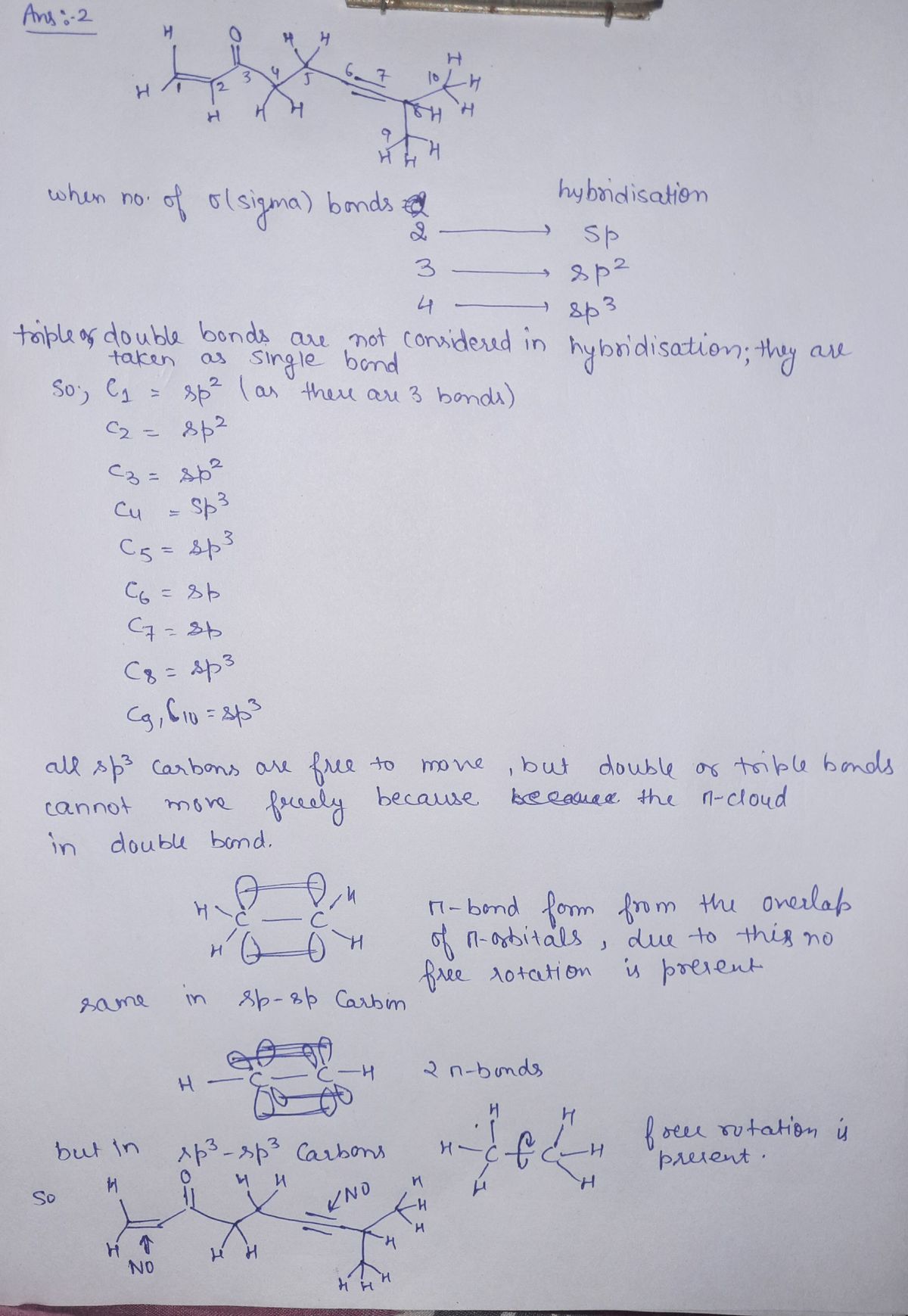1. Indicate the geometry of each carbon atom (i.e., linear, trigonal planar, tetrahedral) H :O: HH 1 S²N=3+0=3 Z 959 C C₁ T H H H 3+0=3 - trigonal = 3+0=3 = 4+0=4 = 4+0=4 = 4+0=4 2 = 4+0=4 = 4+0=4 - tetrahedral H H BH TH CH H 2. Use hybridization and orbitals to explain why some bonds above rotate freely and other bonds do not. Feel free to draw to explain your answer H → Sp² hybridization → Sp2-hybridization (trigonal) hybridization C3Sp2- C4 SP3 -hybridization Cz→ SP³ -hybridization Cos S.N=no. of bond + no. of won ar Lone POL Cs→Sp3-hybridization tetrahedral Cu→Sp3-hybridization G→Sp³-hybridization
1. Indicate the geometry of each carbon atom (i.e., linear, trigonal planar, tetrahedral) H :O: HH 1 S²N=3+0=3 Z 959 C C₁ T H H H 3+0=3 - trigonal = 3+0=3 = 4+0=4 = 4+0=4 = 4+0=4 2 = 4+0=4 = 4+0=4 - tetrahedral H H BH TH CH H 2. Use hybridization and orbitals to explain why some bonds above rotate freely and other bonds do not. Feel free to draw to explain your answer H → Sp² hybridization → Sp2-hybridization (trigonal) hybridization C3Sp2- C4 SP3 -hybridization Cz→ SP³ -hybridization Cos S.N=no. of bond + no. of won ar Lone POL Cs→Sp3-hybridization tetrahedral Cu→Sp3-hybridization G→Sp³-hybridization
Chemistry
10th Edition
ISBN:9781305957404
Author:Steven S. Zumdahl, Susan A. Zumdahl, Donald J. DeCoste
Publisher:Steven S. Zumdahl, Susan A. Zumdahl, Donald J. DeCoste
Chapter1: Chemical Foundations
Section: Chapter Questions
Problem 1RQ: Define and explain the differences between the following terms. a. law and theory b. theory and...
Related questions
Concept explainers
Bond Parameters
Many factors decide the covalent bonding between atoms. Some of the bond parameters are bond angle, bond order, enthalpy, bond length, etc. These parameters decide what kind of bond will form in atoms. Hence it is crucial to understand these parameters in detail and understand how changing these parameters affects the kind of bonding or various characteristics.
Bond Dissociation Energy
The tendency of an atom to attract an electron is known as its electronegativity.
Question
Please explain no. 2 in deyail

Transcribed Image Text:1. Indicate the geometry of each carbon atom (i.e., linear, trigonal planar, tetrahedral).
디
C₁ S₁N=3+0=3
= 3+0=3
= 3+0=3
64 C = 4+0=4
=4+0=4
مرين
сз
H
8
HI
Н
H H:O:
H9
H H
-trigonal
tetrahedral
H
HO?
hybridization
C3-> Sp2-
C4 SP3 -hybridization
6H
&H
HOT H
H₁
I I
C₁ → Sp² hybridization
C₂ Sp²-hybridization trig
= 4+0=4
= 4+0=4
= 4+0=4
2. Use hybridization and orbitals to explain why some bonds above rotate freely and other
bonds do not. Feel free to draw to explain your answer
S.N=no. of bond
+ no. of
Lone
Pair
Cs→Sp3-hybridization tetrahedral
C-Sp3-hybridization
G→SP³-hybridization.
Cg → SP3 -hybridization
8
Expert Solution
Step 1

Step by step
Solved in 2 steps with 1 images

Knowledge Booster
Learn more about
Need a deep-dive on the concept behind this application? Look no further. Learn more about this topic, chemistry and related others by exploring similar questions and additional content below.Recommended textbooks for you

Chemistry
Chemistry
ISBN:
9781305957404
Author:
Steven S. Zumdahl, Susan A. Zumdahl, Donald J. DeCoste
Publisher:
Cengage Learning

Chemistry
Chemistry
ISBN:
9781259911156
Author:
Raymond Chang Dr., Jason Overby Professor
Publisher:
McGraw-Hill Education

Principles of Instrumental Analysis
Chemistry
ISBN:
9781305577213
Author:
Douglas A. Skoog, F. James Holler, Stanley R. Crouch
Publisher:
Cengage Learning

Chemistry
Chemistry
ISBN:
9781305957404
Author:
Steven S. Zumdahl, Susan A. Zumdahl, Donald J. DeCoste
Publisher:
Cengage Learning

Chemistry
Chemistry
ISBN:
9781259911156
Author:
Raymond Chang Dr., Jason Overby Professor
Publisher:
McGraw-Hill Education

Principles of Instrumental Analysis
Chemistry
ISBN:
9781305577213
Author:
Douglas A. Skoog, F. James Holler, Stanley R. Crouch
Publisher:
Cengage Learning

Organic Chemistry
Chemistry
ISBN:
9780078021558
Author:
Janice Gorzynski Smith Dr.
Publisher:
McGraw-Hill Education

Chemistry: Principles and Reactions
Chemistry
ISBN:
9781305079373
Author:
William L. Masterton, Cecile N. Hurley
Publisher:
Cengage Learning

Elementary Principles of Chemical Processes, Bind…
Chemistry
ISBN:
9781118431221
Author:
Richard M. Felder, Ronald W. Rousseau, Lisa G. Bullard
Publisher:
WILEY